What We’re Reading: April 6th
Review: The origin and evolution of mycorrhizal symbioses
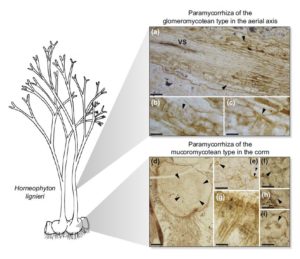 Many fungi are pathogens that kill or weaken their plant hosts. However, there are also many species that form beneficial relationships with plants, algae, and cyanobacteria. One of these mutualisms is the mycorrhizal association between a fungus and a plant root, where the fungus provides the plant with nitrogen or phosphorus in exchange for carbon or sugar. Although it is estimated that 85% of all plant species have a mycorrhizal association, the diversity and phylogenetic relationships of these incredible fungi has been relatively poorly studied. Strullu‐Derrien et al. review “the main phases of the evolution of mycorrhizal interactions from palaeontological, phylogenetic and genomic perspectives.” There is evidence of mycorrhizal mutualisms in plant fossils dating back at least 407 million years! In recent years new studies have identified several waves of evolution and diversification. Furthermore, some believe that these amazing fungi not only help shape the genome evolution and speciation of plants, but are also “active agents of environmental change” through their role in the carbon cycle. (Summary by Jason Stettler) New Phytol. 10.1111/nph.15076
Many fungi are pathogens that kill or weaken their plant hosts. However, there are also many species that form beneficial relationships with plants, algae, and cyanobacteria. One of these mutualisms is the mycorrhizal association between a fungus and a plant root, where the fungus provides the plant with nitrogen or phosphorus in exchange for carbon or sugar. Although it is estimated that 85% of all plant species have a mycorrhizal association, the diversity and phylogenetic relationships of these incredible fungi has been relatively poorly studied. Strullu‐Derrien et al. review “the main phases of the evolution of mycorrhizal interactions from palaeontological, phylogenetic and genomic perspectives.” There is evidence of mycorrhizal mutualisms in plant fossils dating back at least 407 million years! In recent years new studies have identified several waves of evolution and diversification. Furthermore, some believe that these amazing fungi not only help shape the genome evolution and speciation of plants, but are also “active agents of environmental change” through their role in the carbon cycle. (Summary by Jason Stettler) New Phytol. 10.1111/nph.15076
Review: Key questions and challenges in angiosperm macroevolution
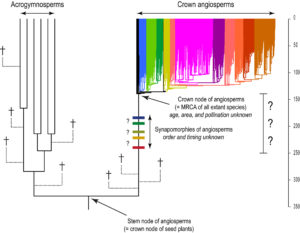 Are you curious about why and how angiosperms, flowering plants, are the youngest lineage of land plants and have become the most abundant group of plants? You are not alone. Generations of botanists and evolutionary biologists have wondered about this same thing. Many questions have been answered, such as the evolutionary relationships between the families of angiosperms. However, many questions have not been answered. This Review by Sauquet and Magallón addresses questions like: What are the ancestors of angiosperms? How old is this group? How variable has their diversification been through time and across lineages? For most of these questions there is no good answer. For example the estimated age of angiosperms spans a timeline of 110 million years which is too broad to rely on. Evolutionary biologists are invited to coordinate a global effort to address the unanswered questions in angiosperm macroevolution. (Summary by Jason Stettler) New Phytol. 10.1111/nph.15104
Are you curious about why and how angiosperms, flowering plants, are the youngest lineage of land plants and have become the most abundant group of plants? You are not alone. Generations of botanists and evolutionary biologists have wondered about this same thing. Many questions have been answered, such as the evolutionary relationships between the families of angiosperms. However, many questions have not been answered. This Review by Sauquet and Magallón addresses questions like: What are the ancestors of angiosperms? How old is this group? How variable has their diversification been through time and across lineages? For most of these questions there is no good answer. For example the estimated age of angiosperms spans a timeline of 110 million years which is too broad to rely on. Evolutionary biologists are invited to coordinate a global effort to address the unanswered questions in angiosperm macroevolution. (Summary by Jason Stettler) New Phytol. 10.1111/nph.15104
Review: Heat and drought tolerance in wheat – now and for the future
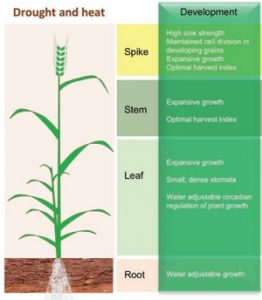 Stress due to high heat and drought causes losses in wheat production all over the world. While genetic variation and quantitative trait loci for drought and heat tolerance are known, the genetic loci that underlie tolerance to these combined stress are likely different from those that underlie each stress alone, as responses to these stresses can be antagonistic. For example, when water is plentiful wheat can tolerate high temperatures through evaporative cooling, but this is not possible when heat is accompanied by drought. This review by Tricker and colleagues describes the known physiological traits and genetic control of heat and drought tolerance of wheat and discusses physiological traits that may underlie combined tolerance. The authors discuss opportunities and limitations in breeding for more tolerant varieties. They note that controlling water relations by management of spatial and temporal gas exchange would be useful for better combined tolerance in wheat. (Summary by Julia Miller) J. Exp. Bot. 10.1093/jxb/ery081
Stress due to high heat and drought causes losses in wheat production all over the world. While genetic variation and quantitative trait loci for drought and heat tolerance are known, the genetic loci that underlie tolerance to these combined stress are likely different from those that underlie each stress alone, as responses to these stresses can be antagonistic. For example, when water is plentiful wheat can tolerate high temperatures through evaporative cooling, but this is not possible when heat is accompanied by drought. This review by Tricker and colleagues describes the known physiological traits and genetic control of heat and drought tolerance of wheat and discusses physiological traits that may underlie combined tolerance. The authors discuss opportunities and limitations in breeding for more tolerant varieties. They note that controlling water relations by management of spatial and temporal gas exchange would be useful for better combined tolerance in wheat. (Summary by Julia Miller) J. Exp. Bot. 10.1093/jxb/ery081
Review: The root transition zone: A hot spot for signal crosstalk ($)
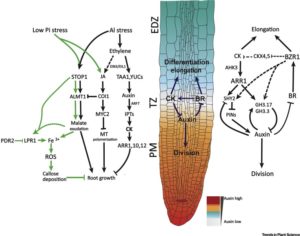 Plant roots are an excellent system to study the interactions between endogenous (phytohormones) and exogenous (abiotic stresses) stimuli. The root can be considered as three sections: the meristematic zone (where active cell division occurs), the transition zone (acting as a boundary between meristem and elongation zones), and the elongation and differentiation zone (where cells elongate and root hairs start to form). Hormonal crosstalk and the perception of aluminum and low phosphate stress occur in the transition zone. In this review, Kong et al. focus on the genetic circuitry between phytohormones and abiotic stress regulation in the root transition zone. They also discuss future research opportunities related to the role of the transition zone in response to other abiotic stresses, such as drought and salt stress. (Summary by Arif Ashraf) Trends Plant Sci. 10.1016/j.tplants.2018.02.004
Plant roots are an excellent system to study the interactions between endogenous (phytohormones) and exogenous (abiotic stresses) stimuli. The root can be considered as three sections: the meristematic zone (where active cell division occurs), the transition zone (acting as a boundary between meristem and elongation zones), and the elongation and differentiation zone (where cells elongate and root hairs start to form). Hormonal crosstalk and the perception of aluminum and low phosphate stress occur in the transition zone. In this review, Kong et al. focus on the genetic circuitry between phytohormones and abiotic stress regulation in the root transition zone. They also discuss future research opportunities related to the role of the transition zone in response to other abiotic stresses, such as drought and salt stress. (Summary by Arif Ashraf) Trends Plant Sci. 10.1016/j.tplants.2018.02.004
Viewpoint: Cell-cell junctions: What’s their function?
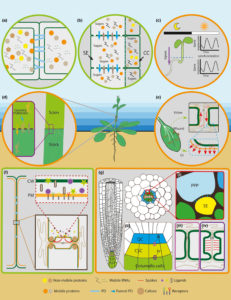 Plasmodesmata are contiguous cell-cell junctions that provide an avenue for intracellular (symplastic) communication between neighboring plant cells. In recent years, researchers have unravelled key aspects of plasmodesmata development and function in cell-cell signalling during a multitude of responses to endogenous or external stimuli. In a recent Viewpoint article, Lu et al. discuss these advances and suggest that future studies focused on translating structural observations into functional mechanisms will be of particular importance in understanding how plasmodesmata regulate symplastic communication during localized and systemic responses. (Summary by Phil Carella) New Phytol. 10.1111/nph.15130
Plasmodesmata are contiguous cell-cell junctions that provide an avenue for intracellular (symplastic) communication between neighboring plant cells. In recent years, researchers have unravelled key aspects of plasmodesmata development and function in cell-cell signalling during a multitude of responses to endogenous or external stimuli. In a recent Viewpoint article, Lu et al. discuss these advances and suggest that future studies focused on translating structural observations into functional mechanisms will be of particular importance in understanding how plasmodesmata regulate symplastic communication during localized and systemic responses. (Summary by Phil Carella) New Phytol. 10.1111/nph.15130
Breakthrough Technology: Soft X-ray imaging of cellular carbon and nitrogen distributions in heterocystous cyanobacterium
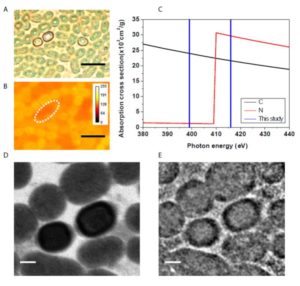 Soft X-ray imaging is a promising new technology that can be used to measure elemental compositions of living cells. By adjusting the energy (wavelength) of the incident X-rays, it is possible to specifically measure C or N, which have different photo-absorption edges. Teramoto et al. demonstrate the power of soft X-ray microscopy (SXM) by imaging carbon and nitrogen levels in distinct cell types of the nitrogen-fixing photosynthetic cyanobacterium Anabaena sp. PCC 7120. When nitrogen is limiting, certain cells differentiate into nitrogen-fixing heterocysts, which exchange the resulting N-rich compounds for C-rich compounds produced by the photosynthetic vegetative cells. Using SXM, the authors were able to quantify C, N, and C/N ratios in the two cell types. The authors observe that this method can be applied to other systems for example to study oil-producing algae and algal carbon-concentrating structures. (Summary by Mary Williams) Plant Physiol. 10.1104/pp.17.01767
Soft X-ray imaging is a promising new technology that can be used to measure elemental compositions of living cells. By adjusting the energy (wavelength) of the incident X-rays, it is possible to specifically measure C or N, which have different photo-absorption edges. Teramoto et al. demonstrate the power of soft X-ray microscopy (SXM) by imaging carbon and nitrogen levels in distinct cell types of the nitrogen-fixing photosynthetic cyanobacterium Anabaena sp. PCC 7120. When nitrogen is limiting, certain cells differentiate into nitrogen-fixing heterocysts, which exchange the resulting N-rich compounds for C-rich compounds produced by the photosynthetic vegetative cells. Using SXM, the authors were able to quantify C, N, and C/N ratios in the two cell types. The authors observe that this method can be applied to other systems for example to study oil-producing algae and algal carbon-concentrating structures. (Summary by Mary Williams) Plant Physiol. 10.1104/pp.17.01767
Translational coincidence in Arabidopsis
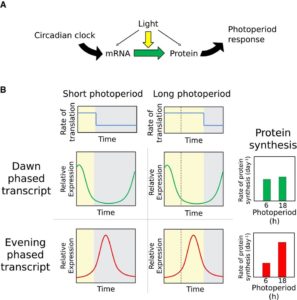 Changes in photoperiod affect metabolism and development, as well as flowering time, hypocotyl elongation, freezing tolerance, stomatal opening, C-allocation and growth. Seaton and collaborators measured the Arabidopsis proteome under four photoperiods: 6h, 8h, 12h and 18 hours. At longer photoperiods, enzymes involved in primary and secondary metabolism and photosynthesis were more abundant, consistent with the higher metabolic activity in long days. The protein abundance was observed to be affected by both clock-regulated transcription and light-regulated translation rates. A mathematical model describes this “translational coincidence”; it explains the differences in protein synthesis rates across photoperiods depending on the genes’ circadian regulation. For instance, an evening-phased transcript would have high transcript levels coinciding with light-mediated high translation rates only under long photoperiods. A similar mechanism was observed by analyzing data from other phototrophs. As the authors conclude, “Translational coincidence can explain how plants adjust their proteome to prevailing photoperiods, optimising their metabolism and growth.” (Summary by Cecilia Vasquez-Robinet) Mol. Syst. Biol. 10.15252/msb.20177962
Changes in photoperiod affect metabolism and development, as well as flowering time, hypocotyl elongation, freezing tolerance, stomatal opening, C-allocation and growth. Seaton and collaborators measured the Arabidopsis proteome under four photoperiods: 6h, 8h, 12h and 18 hours. At longer photoperiods, enzymes involved in primary and secondary metabolism and photosynthesis were more abundant, consistent with the higher metabolic activity in long days. The protein abundance was observed to be affected by both clock-regulated transcription and light-regulated translation rates. A mathematical model describes this “translational coincidence”; it explains the differences in protein synthesis rates across photoperiods depending on the genes’ circadian regulation. For instance, an evening-phased transcript would have high transcript levels coinciding with light-mediated high translation rates only under long photoperiods. A similar mechanism was observed by analyzing data from other phototrophs. As the authors conclude, “Translational coincidence can explain how plants adjust their proteome to prevailing photoperiods, optimising their metabolism and growth.” (Summary by Cecilia Vasquez-Robinet) Mol. Syst. Biol. 10.15252/msb.20177962
An epigenetic origin behind the transgenerational fitness decline in plants impaired in replication-coupled chromatin assembly ($)
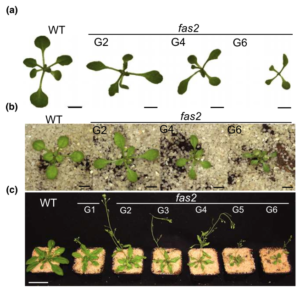 Packaging of nuclear DNA in chromatin is critical for the maintenance of genome integrity as well as fundamental cellular processes such as DNA replication and transcription. Chromatin assembly is mediated by histone chaperones, such as Chromatin Assembly Factor 1 (CAF-1). CAF-1 ensures faithful replication-coupled chromatin assembly. Arabidopsis plants lacking a functional CAF-1 show molecular and developmental defects of increasing intensity after repeated propagation by selfing. Nevertheless, the molecular basis of this rise in phenotype severity remains unclear. In this study, Mozgova et al. monitored the transgenerational phenotypic aggravation of caf-1 mutants and associated changes in the transcriptome and methylome. They first confirmed the progressive aggravation of phenotypic defects through caf-1 generations, and pinpointed defects in ovule development as a major cause of sterility in late caf-1 generations. By comparing the transcriptome of early vs. late generation of caf-1 mutants, they further showed changes in transcription in defense-related genes, mirroring the transgenerational aggravation of the phenotype. Methylome analysis revealed changes in DNA methylation at transposable elements through generations, while genes remained globally unaffected. Remarkably, reciprocal crosses between early (G1) and late (G4) caf-1 generations argued for a major maternal contribution to the defective phenotype. Together, this study provides new insights in the molecular basis of phenotypic aggravation in plants lacking CAF-1, and stresses out the importance of replication-coupled chromatin assembly in the faithful transmission of the epigenome and the transcriptional program. (Summary by Matthias Benoit) New Phytol. 10.1111/nph.15082
Packaging of nuclear DNA in chromatin is critical for the maintenance of genome integrity as well as fundamental cellular processes such as DNA replication and transcription. Chromatin assembly is mediated by histone chaperones, such as Chromatin Assembly Factor 1 (CAF-1). CAF-1 ensures faithful replication-coupled chromatin assembly. Arabidopsis plants lacking a functional CAF-1 show molecular and developmental defects of increasing intensity after repeated propagation by selfing. Nevertheless, the molecular basis of this rise in phenotype severity remains unclear. In this study, Mozgova et al. monitored the transgenerational phenotypic aggravation of caf-1 mutants and associated changes in the transcriptome and methylome. They first confirmed the progressive aggravation of phenotypic defects through caf-1 generations, and pinpointed defects in ovule development as a major cause of sterility in late caf-1 generations. By comparing the transcriptome of early vs. late generation of caf-1 mutants, they further showed changes in transcription in defense-related genes, mirroring the transgenerational aggravation of the phenotype. Methylome analysis revealed changes in DNA methylation at transposable elements through generations, while genes remained globally unaffected. Remarkably, reciprocal crosses between early (G1) and late (G4) caf-1 generations argued for a major maternal contribution to the defective phenotype. Together, this study provides new insights in the molecular basis of phenotypic aggravation in plants lacking CAF-1, and stresses out the importance of replication-coupled chromatin assembly in the faithful transmission of the epigenome and the transcriptional program. (Summary by Matthias Benoit) New Phytol. 10.1111/nph.15082
Deep Evolutionary Roots for the Plant Hormone Auxin
 Auxin is an endogenous plant hormone that orchestrates complex tissue development across diverse green plant lineages. In a recent article, Mutte et al. performed a deep phylogenomics analysis of known and predicted auxin signalling mechanisms present in green plants and their algal predecessors. This analysis revealed interesting contributions of ancient proteins to the auxin response pathway and demonstrated the stepwise expansion and sophistication of auxin signalling mechanisms throughout plant evolution. The authors provide a strong evolutionary framework for nuclear auxin signalling that stands as an excellent model for future phylogenomics studies centered on the evolution of complex pathways in plants. (Summary by Phil Carella) eLIFE 10.7554/eLife.33399
Auxin is an endogenous plant hormone that orchestrates complex tissue development across diverse green plant lineages. In a recent article, Mutte et al. performed a deep phylogenomics analysis of known and predicted auxin signalling mechanisms present in green plants and their algal predecessors. This analysis revealed interesting contributions of ancient proteins to the auxin response pathway and demonstrated the stepwise expansion and sophistication of auxin signalling mechanisms throughout plant evolution. The authors provide a strong evolutionary framework for nuclear auxin signalling that stands as an excellent model for future phylogenomics studies centered on the evolution of complex pathways in plants. (Summary by Phil Carella) eLIFE 10.7554/eLife.33399
Arabidopsis TSO1 and MYB3R1 form a regulatory module to coordinate cell proliferation with differentiation in shoot and root
 In order to ensure proper development, plants need to balance cell proliferation and differentiation. Mutation in TSO1 causes disorganization of cell layers, leading to drastic reduction in fertility. A mutagenesis screen for rescue of fertility in the tso1-1 background identified MYB3R1 as major partner of TSO1 in cell organization and cell cycle control. In the tso1-1 background, MYB31R expression was ubiquitous, indicating that TSO1 is involved in repression of MYB31R transcription. The expression of TSO1 and MYB3R1 was observed to be complementary in the developing root. As both genes are homologues of DREAM complex that coordinates cell cycle progression in animal cells, this work by Wang et al. suggest that the DREAM-like mechanisms are also important for cell cycle control in the plant kingdom. (Summary by Magdalena Julkowska) PNAS
In order to ensure proper development, plants need to balance cell proliferation and differentiation. Mutation in TSO1 causes disorganization of cell layers, leading to drastic reduction in fertility. A mutagenesis screen for rescue of fertility in the tso1-1 background identified MYB3R1 as major partner of TSO1 in cell organization and cell cycle control. In the tso1-1 background, MYB31R expression was ubiquitous, indicating that TSO1 is involved in repression of MYB31R transcription. The expression of TSO1 and MYB3R1 was observed to be complementary in the developing root. As both genes are homologues of DREAM complex that coordinates cell cycle progression in animal cells, this work by Wang et al. suggest that the DREAM-like mechanisms are also important for cell cycle control in the plant kingdom. (Summary by Magdalena Julkowska) PNAS
AUX1-mediated root hair auxin influx governs SCFTIR1/AFB-type Ca2+ signaling
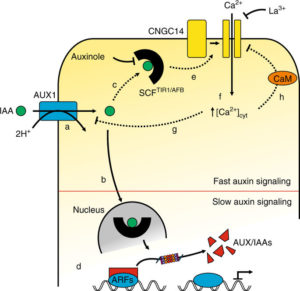 The phytohormone auxin is transported in a polar fashion through PINs (PIN-FORMED) and PGPs (P–GLYCOPROTEIN) as auxin efflux carriers and AUX1 and LAXs (LIKE-AUX1) as influx carriers. Previous experiments from oat coleoptiles and corn root hairs indicate that one of quickest auxin responses is cell membrane depolarization. In this study, Dindas et al. used Arabidopsis root hair cells as a single cell model system to understand auxin signaling in membrane responses. They found that as a part of the early response auxin is perceived by the auxinol-sensitive cytosolic fraction of the SCFTIR1/AFB receptor (auxinol acts as a SCFTIR1/AFB inhibitor). Upon auxin perception, CNGC14 (CYCLIC NUCLEOTIDE GATED CHANNEL 14) activates Ca2+-influx and increases cytosolic Ca2+ levels. Increased cytosolic Ca2+ regulates AUX1-mediated transporter via phosphorylation of AUX1 through Ca2+-dependent kinases. The elevated cytosolic Ca2+ also regulates the activity of CNGC14 through Ca2+-dependent interaction of CNGC14 with calmodulin. (Summary by Arif Ashraf) Nature Comms: 10.1038/s41467-018-03582-5
The phytohormone auxin is transported in a polar fashion through PINs (PIN-FORMED) and PGPs (P–GLYCOPROTEIN) as auxin efflux carriers and AUX1 and LAXs (LIKE-AUX1) as influx carriers. Previous experiments from oat coleoptiles and corn root hairs indicate that one of quickest auxin responses is cell membrane depolarization. In this study, Dindas et al. used Arabidopsis root hair cells as a single cell model system to understand auxin signaling in membrane responses. They found that as a part of the early response auxin is perceived by the auxinol-sensitive cytosolic fraction of the SCFTIR1/AFB receptor (auxinol acts as a SCFTIR1/AFB inhibitor). Upon auxin perception, CNGC14 (CYCLIC NUCLEOTIDE GATED CHANNEL 14) activates Ca2+-influx and increases cytosolic Ca2+ levels. Increased cytosolic Ca2+ regulates AUX1-mediated transporter via phosphorylation of AUX1 through Ca2+-dependent kinases. The elevated cytosolic Ca2+ also regulates the activity of CNGC14 through Ca2+-dependent interaction of CNGC14 with calmodulin. (Summary by Arif Ashraf) Nature Comms: 10.1038/s41467-018-03582-5
Biosynthesis of redox active metabolites in response to iron deficiency in plants
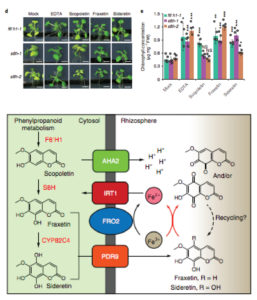 Iron is an essential but poorly bioavailable micronutrient that serves as a co-factor in many processes involved in electron- or oxygen-transfer. Land-plants evolved at least two distinct mechanism for iron uptake based on chelation of iron by phytosiderophores, that are produced only by grasses, or acidification of the rhizosphere and enzymatic reduction of iron chelates at the root surface. Rajniak et al. identified another iron acquisition mechanism in Arabidopsis, where redox-active metabolites, sideretin and fraxetin, are released from the roots upon iron deficiency in acidic and alkaline conditions respectively. Both metabolites were able to mobilize the insoluble iron and rescue the chlorotic phenotypes of the mutants and plants grown under iron starvation conditions. This work shows that release of the redox-active compounds is sufficient for iron uptake by plants. (Summary by Magdalena Julkowska) Nature Chem Biol. 10.1038/s41589-018-0019-2
Iron is an essential but poorly bioavailable micronutrient that serves as a co-factor in many processes involved in electron- or oxygen-transfer. Land-plants evolved at least two distinct mechanism for iron uptake based on chelation of iron by phytosiderophores, that are produced only by grasses, or acidification of the rhizosphere and enzymatic reduction of iron chelates at the root surface. Rajniak et al. identified another iron acquisition mechanism in Arabidopsis, where redox-active metabolites, sideretin and fraxetin, are released from the roots upon iron deficiency in acidic and alkaline conditions respectively. Both metabolites were able to mobilize the insoluble iron and rescue the chlorotic phenotypes of the mutants and plants grown under iron starvation conditions. This work shows that release of the redox-active compounds is sufficient for iron uptake by plants. (Summary by Magdalena Julkowska) Nature Chem Biol. 10.1038/s41589-018-0019-2
Scopoletin 8-hydroxylase-mediated fraxetin production is crucial for iron mobilization
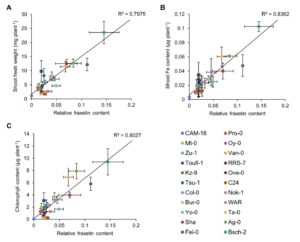 As iron is often limiting in the environment, plants use many strategies to support iron uptake, including secretion of small molecules such as coumarins that can help to mobilize iron from the soil. Tsai et al. examined the role of a gene involved in fraxetin (7,8-dihydroxy-6-methoxycoumarin) production on iron uptake in Arabidopsis. SH8 expression is induced by low iron and encodes scopoletin 8-hydroxylase which catalyzes the final step in fraxetin synthesis. Using a range of natural accessions grown on non-available iron media (navFE), the authors showed a significant correlation with fraxetin production and shoot iron content. (Summary by Mary Williams) Plant Physiol. 10.1104/pp.18.00178
As iron is often limiting in the environment, plants use many strategies to support iron uptake, including secretion of small molecules such as coumarins that can help to mobilize iron from the soil. Tsai et al. examined the role of a gene involved in fraxetin (7,8-dihydroxy-6-methoxycoumarin) production on iron uptake in Arabidopsis. SH8 expression is induced by low iron and encodes scopoletin 8-hydroxylase which catalyzes the final step in fraxetin synthesis. Using a range of natural accessions grown on non-available iron media (navFE), the authors showed a significant correlation with fraxetin production and shoot iron content. (Summary by Mary Williams) Plant Physiol. 10.1104/pp.18.00178
GSN1 coordinates grain number and grain size
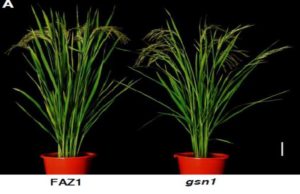 Grain yield is determined by both grain number and grain weight. There is often a trade-off between these traits; for example, increased grain number is often associated with decreased grain weight. Using a forward-genetic approach, Guo et al. have identified a rice gene, GRAIN SIZE AND NUMBER1 (GSN1) that affects these traits. GSN1 encodes a mitogen-activated protein kinase phosphatase. Increasing GSN1 activity leads to more, smaller grains, and decreasing it leads to fewer, larger grains. GSN1 acts by affecting the rate of cell proliferation and interacts with the MAP kinase signaling cascade. (Summary by Mary Williams) Plant Cell 10.1105/tpc.17.00959
Grain yield is determined by both grain number and grain weight. There is often a trade-off between these traits; for example, increased grain number is often associated with decreased grain weight. Using a forward-genetic approach, Guo et al. have identified a rice gene, GRAIN SIZE AND NUMBER1 (GSN1) that affects these traits. GSN1 encodes a mitogen-activated protein kinase phosphatase. Increasing GSN1 activity leads to more, smaller grains, and decreasing it leads to fewer, larger grains. GSN1 acts by affecting the rate of cell proliferation and interacts with the MAP kinase signaling cascade. (Summary by Mary Williams) Plant Cell 10.1105/tpc.17.00959
Arabidopsis ICK/KRP cyclin-dependent kinase inhibitors function to ensure the formation of one megaspore mother cell and one functional megaspore per ovule
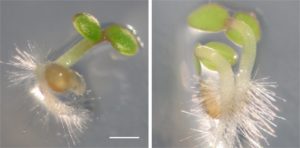 Usually the female germline starts with one MMC (megaspore mother cell) per ovule that becomes four megaspores through the process of meiosis. Out of these four, only one survives to produce a functional megaspore (FM); the other three undergo a degeneration process. The FM forms the embryo sac. In this study, Cao et al. took the advantage of ICK/KRPs (interactor/inhibitor of cyclin-dependent kinase /Kip-related proteins) mutants to understand the selective process of embryo sac formation. In the septuple mutant in which all seven ICK/KRP genes are inactivated, more than one MMC, FM and embryo sac forms. Additionally, the authors demonstrated that ICK4 is only expressed in the degenerated megaspores, not in FM. This work showed that selective embryo sac formation and megaspore degeneration are mediated by the redundant function of ICK/KRPs. (Summary by Arif Ashraf) PLOS Genetics: 10.1371/journal.pgen.1007230
Usually the female germline starts with one MMC (megaspore mother cell) per ovule that becomes four megaspores through the process of meiosis. Out of these four, only one survives to produce a functional megaspore (FM); the other three undergo a degeneration process. The FM forms the embryo sac. In this study, Cao et al. took the advantage of ICK/KRPs (interactor/inhibitor of cyclin-dependent kinase /Kip-related proteins) mutants to understand the selective process of embryo sac formation. In the septuple mutant in which all seven ICK/KRP genes are inactivated, more than one MMC, FM and embryo sac forms. Additionally, the authors demonstrated that ICK4 is only expressed in the degenerated megaspores, not in FM. This work showed that selective embryo sac formation and megaspore degeneration are mediated by the redundant function of ICK/KRPs. (Summary by Arif Ashraf) PLOS Genetics: 10.1371/journal.pgen.1007230
An SPX-RLI1 module regulates leaf inclination in response to phosphate availability in rice
 The angle at which a rice leaf bends affects its ability to intercept light and also the density at which the plants can be sown. Previous work has shown that brassinosteroid hormones and the BRASSINOSTEROID UPREGULATED1 (BU1) gene affect leaf angle. Ruan, Guo, Xu et al. investigated the role of phosphate (Pi) availability in leaf angle; leaves are more erect in low Pi conditions (which interfere with effective photosynthesis), possibly to reduce light capture. The authors showed that the Pi starvation-induced proteins SPX1 and 2, and an SPX1-interacting protein RLI1 (Regulator of Leaf Inclination 1) are involved in BU1 regulation and leaf angle responses to Pi. RLI1 positively regulates cell extension in the leaf lamina (hinge) joint, leading to an increase in leaf angle, which is suppressed in low-Pi. This work then connects leaf angle and Pi sufficiency, which could lead to the production of “new rice cultivars with different canopy forms that are sensitive or insensitiveto Pi availability, which might help to increase Pi efficiency in field.” (Summary by Mary Williams) Plant Cell 10.1105/tpc.17.00738
The angle at which a rice leaf bends affects its ability to intercept light and also the density at which the plants can be sown. Previous work has shown that brassinosteroid hormones and the BRASSINOSTEROID UPREGULATED1 (BU1) gene affect leaf angle. Ruan, Guo, Xu et al. investigated the role of phosphate (Pi) availability in leaf angle; leaves are more erect in low Pi conditions (which interfere with effective photosynthesis), possibly to reduce light capture. The authors showed that the Pi starvation-induced proteins SPX1 and 2, and an SPX1-interacting protein RLI1 (Regulator of Leaf Inclination 1) are involved in BU1 regulation and leaf angle responses to Pi. RLI1 positively regulates cell extension in the leaf lamina (hinge) joint, leading to an increase in leaf angle, which is suppressed in low-Pi. This work then connects leaf angle and Pi sufficiency, which could lead to the production of “new rice cultivars with different canopy forms that are sensitive or insensitiveto Pi availability, which might help to increase Pi efficiency in field.” (Summary by Mary Williams) Plant Cell 10.1105/tpc.17.00738



